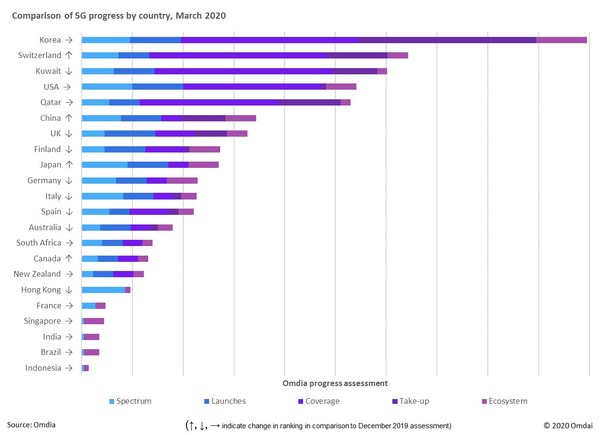LONDON, Oct. 7, 2020 /PRNewswire/ — Global research company OMDIA has released the second version of its Global 5G Progress Update, March 2020 report showing that South Korea is the leading country for 5G deployment in the twenty two leading 5G countries OMDIA analyzed for their deployment of 5G technology.
The OMDIA research assessed the deployment progress of 5G based on operator launches, network coverage, subscriber take-up as well as 5G spectrum availability and regulatory eco-system.
Based on these factors OMDIA’s research concluded that South Korea – as it did in the 4G era – has established itself as the early market-leader for 5G technology deployment with Kuwait and Switzerland following behind.
"Korea is leading the way with adoption reaching 5.88 million at the end of March; approaching ten percent of wireless services in the market," the report says.
"However, expansive coverage rolled out by Sunrise and Swisscom in Switzerland, Ooredoo and Vodafone in Qatar and Kuwait three service providers has rivalled Korea for breadth of market coverage."
Commenting on the report OMDIA Principal Analyst Stephen Myers said:
"The global market is steadily gearing up for 5G deployment but right now South Korea is leading the way – although markets like Switzerland have also made steady progress.
"Despite the COVID pandemic we are seeing governments and regulators pushing ahead with their allocation of 5G spectrum and operators continue to launch and expand 5G network coverage.
"We can expect to see a much larger number of commercial 5G launches in major global markets in the next 12-18 months as more spectrum is released across the world."
Notes to Editors
Ranking Methodology
The ranking used in this report looks to assess the market 5G progress combine the following assessment criteria
- Spectrum available – what is the total spectrum that has been released to service providers for 5G use.
- Service provider launches – how many service providers have launched 5G commercial services. In future editions this will extend to whether 5G services from MVNO have emerged
- Network coverage – what proportion of the population is covered by the live 5G networks. Where specific disclosure have not been made, estimates based on announced deployment programs and coverage maps have been used
- 5G take-up – proportion of total mobile services active on the 5G network. This requires both a 5G enabled device and service plan. Omdia notes some service providers are bundling 5G access into existing service plans at no incremental charge.
- Ecosystem – a more subjective assessment of factors that enhance the adoption of 5G services and creation of value from 5G services. This includes government policy programs, vendors activities and investment, end-user sponsorship and service provider cooperation that facilitate network deployment and service take-up
The combination of these criteria reflect the readiness in markets yet to launch services and development in markets where 5G services have been launched. While using coverage metrics does advantage small geographies, where a large proportion of the population can be covered with 100’s of base stations rather than 1,000’s or 10,000’s, broad and deep coverage remain prerequisite for the transition of services to 5G. As 5G services mature and as enterprise applications become more central to service provider offerings it can be expected the criteria for assessing 5G progress would evolve.
The criteria used reflect the foundational factors for each market (each allocated a 10% weighting)
- How much spectrum been made available for 5G services?
- Have carriers been able to launch commercial services?
- Is there are supportive local ecosystem promoting 5G services?
- The balance of the ranking is split equally between measurable indicators of 5G progress in the form of
- Network coverage
- Take-up
The rankings use a relative assessment, effectively assigning Korea a score of 100% for the September quarter due to its global leadership across all five of the assessment criteria:
- Spectrum – 2,680 MHz across the 3.5 and 28 GHz bands
- Service launches – all three Korean service providers have commercial offerings available to the mass market, and MVNO services have been launched
- Network coverage – approximately 90% population coverage
- 5G take-up – 4.67 million 5G subscribers, or 7% of the mobile market
- Ecosystem – Strong government support and leading local vendor ecosystem
Photo: https://mma.prnasia.com/media2/1308724/5g_global_ranking_march_2020.jpg?p=medium600




